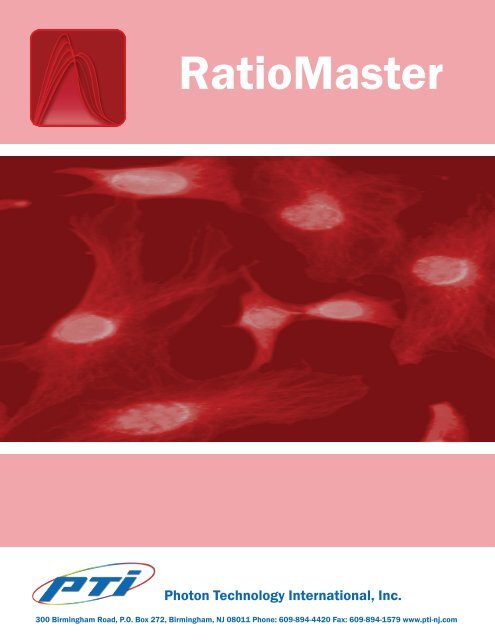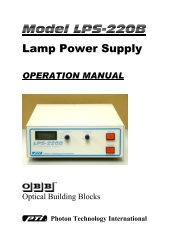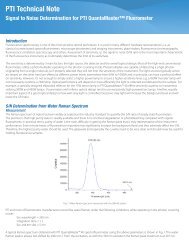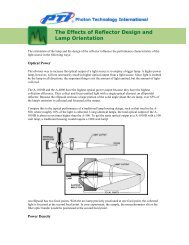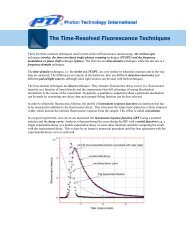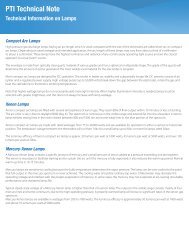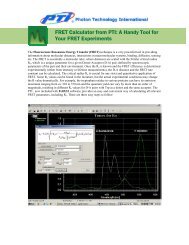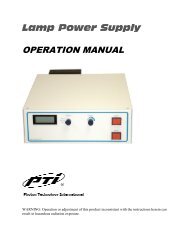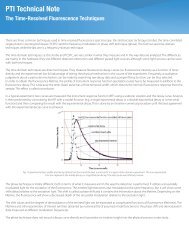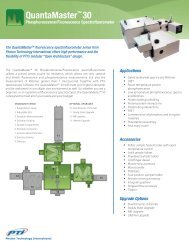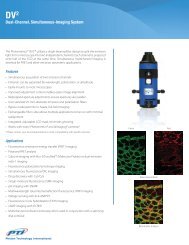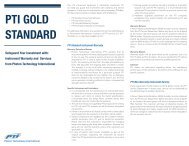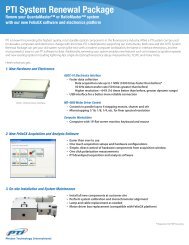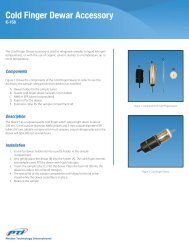Ratiomaster - pti - Photon Technology International
Ratiomaster - pti - Photon Technology International
Ratiomaster - pti - Photon Technology International
You also want an ePaper? Increase the reach of your titles
YUMPU automatically turns print PDFs into web optimized ePapers that Google loves.
RatioMaster<br />
<strong>Photon</strong> <strong>Technology</strong> <strong>International</strong>, Inc.<br />
300 Birmingham Road, P.O. Box 272, Birmingham, NJ 08011 Phone: 609-894-4420 Fax: 609-894-1579 www.<strong>pti</strong>-nj.com
RatioMaster<br />
PTI’s time tested RatioMaster, offering researchers solid, dependable,<br />
sensitive detection for the collection and analysis of ratiometric photometry<br />
data for calcium, pH, and intracellular ion imaging!<br />
The RatioMaster is a microscope-based ratio spectrofluorometer capable of dynamic<br />
ratio fluorescence measurements on a millisecond timescale. A xenon arc lamp provides<br />
high intensity, continuous broadband illumination. Alternating excitation wavelengths are<br />
selected by a computer-controlled high-speed random access monochromator coupled<br />
to a inverted fluorescence microscope with a liquid light guide. Emitted light is collected<br />
from the sample and passed through a photometer with a bilateral translatable iris and a<br />
viewing eyepiece to a switchable analog/photon counting photomultiplier detector. Analog<br />
detection is used when emitted light is relatively intense while low light levels are detected<br />
by photon counting. All system functions are under computer control. Data is collected and<br />
analyzed by proprietary Windows based advanced fluorescence software.<br />
What’s in the Box<br />
•<br />
•<br />
•<br />
•<br />
•<br />
•<br />
DeltaRam X monochromator<br />
2 meter liquid light guide<br />
D104 microscope photometer<br />
FelixGX software<br />
PTI electronics interface<br />
Installation and training<br />
The RatioMaster is the most<br />
sensitive solution if you are<br />
looking at a single region of<br />
interest<br />
Liquid Light Guide Adapter<br />
For All Common Fluorescence<br />
Microscopes<br />
•<br />
•<br />
•<br />
•<br />
•<br />
•<br />
Leica<br />
Zeiss<br />
Nikon<br />
Olympus<br />
Both inverted and upright<br />
configurations<br />
Epi or direct coupling
DeltaRAM X Specifications<br />
•<br />
•<br />
•<br />
•<br />
Excitation wavelength range:<br />
330–650 nm<br />
Wavelength selection speed:<br />
< 2 milliseconds<br />
Wavelength bandwidth adjustable<br />
from 0–24 nm<br />
Two meter Liquid Light Guide and<br />
adapter for a user specified or<br />
supplied fluorescence microscope<br />
Power Supply and Lamp<br />
Specifications<br />
• 75 Watt compact arc xenon bulb<br />
• 200 nm to 2 microns<br />
• Thermally-matched front surface<br />
ellipsoidal reflector for 70%<br />
efficiency<br />
• No cooling or ozone venting<br />
required<br />
Liquid Light Guide<br />
Specifications<br />
• 2 mm core<br />
• 2 meters long<br />
•<br />
Light transmission from 300–650<br />
nm<br />
EasyRatioPro Hardware Features<br />
Hardware<br />
DeltaRAM X Random Access Monochromator<br />
PTI’s innovative DeltaRAM X represents the next bold step in the evolution of light<br />
sources. The compact, patented single monochromator design permits the selection of<br />
any wavelength in two milliseconds or less. This means it can perform up to 250 ratios per<br />
second! It is ideally suited for multi-wavelength applications as well as excitation scanning.<br />
The combination of the DeltaRAM’s tuneability with two bilateral slits sanction the ultimate<br />
in bandpass and throughput flexibility. This allows the user to choose any bandpass desired<br />
from 0-24 nm to maximize the dynamic range of ratiometric dyes knowing that filters have<br />
a fixed band pass. The DeltaRAM X features a computer controlled shutter to prevent<br />
photobleaching for photosensitive samples. An essential feature of the DeltaRAM X<br />
is that it delivers powerful excitation wavelengths from 250–650 nm under synch-lock<br />
computer control. Synch–lock control locks the DeltaRAM X to the detector’s exposure<br />
time or camera frame readout.<br />
Lamp and Power Supply<br />
PTI lamp power supplies are highly regulated DC units that provide very stable power for your<br />
choice of xenon, mercury, or combination mercury-xenon short arc lamps as well as tungstenhalogen<br />
lamps. Every RatioMaster system comes standard with a 75 Watt xenon source<br />
coupled to the DeltaRAM X. This delivers the ultimate in application flexibility by providing<br />
a broadband source from 200 nm to 2 microns that the DeltaRAM X monochromator then<br />
precisely separates into monochromatic light to meet your requirements.<br />
Liquid Light Guide and Microscope Adapter<br />
The RatioMaster system features a two-meter Liquid Light Guide (LLG) to deliver light<br />
to your sample. Typically, a fiber is used for this purpose. However, due to its gel matrix<br />
consistency, the flexible LLG delivers 30% more light, and is not susce<strong>pti</strong>ble to dead spots<br />
or hot spots like traditional fibers. It can be coupled to your choice of any commercially<br />
available fluorescence microscope with an Epi or direct port. The microscope adapters we<br />
provide are customized to match each microscope for light efficiency and a homogenous<br />
sample illumination.
RatioMaster Photometer<br />
Hardware<br />
The fluorescence emission from cells on the microscope stage is measured with PTI’s<br />
proprietary D-104 photometer, featuring an analog and digital PMT readout. The D-104<br />
photometer incorporates an eyepiece to visually observe the cells on the microscope stage.<br />
By adjusting a pair of vertical and horizontal apertures in the field of view, a small number<br />
of cells, a single cell, or even a portion of a cell can be isolated for measurements. An<br />
o<strong>pti</strong>onal camera mount can replace the eyepiece for digital visualization. After identifying<br />
the area of interest you wish to measure, simply toggle the built-in flipping mirror from<br />
‘view’ to ‘measure’ to direct the emission from the microscope through an interchangeable<br />
filter to the photomultiplier tube for photon counting or analog detection.<br />
For dual-emission probes, PTI offers a dual detection solution by mounting a second<br />
detector to the D-104 photometer. A dichroic beam splitter is placed in the photometer<br />
to direct the appropriate emission wavelengths to each detector for simultaneous dual<br />
detection readout.<br />
This detection system excels at<br />
applications such as the following:<br />
• Live-cell imaging<br />
• High-speed emission ratio imaging<br />
• Quantitative FRET, FRAP, FISH<br />
• Luminescence<br />
• Electrophysiology<br />
• Many more…<br />
About The Detection<br />
O<strong>pti</strong>onal Dual Channel<br />
detection for emission<br />
shifted dyes!<br />
Your application needs may change on a daily basis. PTI recognizes this fact and that is<br />
why we offer our standard detection system with both analog and digital detection. Digital,<br />
or photon counting, is the most sensitive as individual photon events are recorded. This<br />
type of detection is mainly used in low light level applications. Analog counting monitors<br />
the current that is being produced through the dynodes of the PMT, and thus is capable<br />
of higher intensity recordings than in digital mode. Analog detection is used mainly in high<br />
light level applications.<br />
Specifications<br />
• Universal C-mount adapter<br />
• Analog and digital PMT<br />
• LCD readout display<br />
• 1 inch filter holder<br />
• Horizontal and vertical aperture<br />
adjustments
Software<br />
• Excitation Ratio<br />
• Emission Ratio<br />
• Excitation Scan<br />
• Emission Scan<br />
• Multiple Dyes<br />
• Timebased<br />
• Calculate FRET Parameters<br />
• Determine Ro • Transform Commands<br />
• Concentration Map<br />
• Concentration Equation<br />
• Lookup Table<br />
• Data Analysis<br />
Other Features of the<br />
Software:<br />
• Square, area of interest<br />
photometry in real-time or in<br />
post acquisition.<br />
• Trace math analysis<br />
functions such as antilog,<br />
average, combine, XY<br />
combine, differentiate,<br />
integrate, linear fit, and peak<br />
finder.<br />
• Real-time generation of user<br />
defined event markers and<br />
event journaling.<br />
• Real-time non-destructive<br />
ratiometric calculation, and<br />
background subtraction.<br />
• Export of data to popular<br />
formats such as .ana, .ang,<br />
.spc or text files.<br />
• Control of up to 10<br />
excitation, emission<br />
channels<br />
•<br />
Unlimited derived channels.<br />
About the Software<br />
Software<br />
From fixed cell preparations to dynamic events, FelixGX fluorescence software represents<br />
the ultimate, expandable platform for professional live cell single region of interest<br />
applications. There is no other system that delivers the sensitivity, flexibility, and capability<br />
of o<strong>pti</strong>ons as the FelixGX software platform.<br />
Data Integrity<br />
PTI knows how valuable your data is, which is why we use a database to archive and store<br />
experimental data. The raw data integrity is kept, allowing the researcher to manipulate<br />
data with peace of mind that their data remains in its original form on the hard drive.<br />
Open Architecture<br />
FelixGX software also allows for maximum flexibility for your future needs with our modular<br />
software architecture. Components can be added to the system to increase functionality.<br />
This feature allows researchers to get started inexpensively and then add functionality later<br />
as their research grows.<br />
Day to Day Routine<br />
Session templates for common experiments are provided. In addition, you can create your<br />
own templates. Ready to run common experiments “out of the box” with minimal input from<br />
the user. Just push acquire and go!<br />
Modular Design<br />
If the out of the box acquisition protocols do not quite fit your applications, the PTI Macro<br />
editor allows you to create your own specialized experiments by a drag and drop command<br />
library into a loop logic. This means you do not have to be a programmer or understand<br />
a scri<strong>pti</strong>ng language to implement user defined macros. You simply select the function<br />
you want and then apply it to the loop. This allows the researcher to increment the start<br />
excitation wavelength, emission wavelength, number of points per second, increase<br />
temperature and a host of other acquisition modes. The Macro editor is simply one of the<br />
easiest to use ever designed by PTI!
Excitation spectrum of Fura-AM<br />
Applications<br />
RatioMaster Is Up For The Task Of Many Applications<br />
Fura-2 Titration<br />
Complete hydrolysis<br />
of the membrane<br />
permeable form of Fura-<br />
2 (Fura-2/AM) to Fura-2<br />
is critical for accurate<br />
measurement. Fura-<br />
2/AM has a different<br />
excitation spectrum<br />
compared with Fura-2.<br />
The scanning property<br />
of our monochromator<br />
makes it easy to check<br />
the status of Fura-2/AM<br />
hydrolysis.<br />
The fluorescence excitation spectrum of Fura-2 shifts to the lower wavelength upon Ca ++<br />
binding. This is a major characteristic of an ion-specific ratio fluorescent dye.<br />
Excitation-Shifted<br />
Emission-Shifted<br />
Frequently Used<br />
Application Dye<br />
Calcium Fura-2,<br />
Fura PE3<br />
FFP18<br />
Quin-2<br />
Fura-Red<br />
Sodium SBFI<br />
BCECF<br />
HPTS<br />
SNAFL®<br />
DM-NERF®<br />
CI-NERF®<br />
Potassium PBFI<br />
Magnesium Mag-Fura-2<br />
Mag-Fura-5<br />
Membrane Di-4-ANEPPS<br />
Potential Di-8-ANEPPS<br />
Application Dye<br />
Calcium Indo-1<br />
pH SNARF-1®<br />
SNARF-2®<br />
Magnesium Mag-Indo-1<br />
Membrane Pyrene Fas<br />
Fluidity PATMAN<br />
Free Fatty ADIFABTM<br />
Acids<br />
Membrane JC-1<br />
Potential<br />
Lipids, Nile Red<br />
phoholipids<br />
Nucleic acids Acridine<br />
Orange
Non-Ratiometric<br />
Dual Dye<br />
Fluorescence Dyes<br />
Application Dye<br />
Calcium Fluo-3<br />
Calcium Green<br />
Calcium Orange<br />
Calcium Crimson<br />
Rhod-2<br />
Chloride SPQ<br />
SPA<br />
MQAE<br />
HIV protease HIV protein substrate<br />
F-actin phallotoxins<br />
PKC Fim-1<br />
Rim-1<br />
Application Dye<br />
Nucleic DAPI and FITC<br />
acids FITC and APC<br />
Fura<br />
Red and BCECF<br />
FITC and Texas Red®<br />
DAPI and PE<br />
And Many More!<br />
In-Situ Calibration of Intracellular [Ca 2+ ] i<br />
By measuring the<br />
ratio of fluorescent<br />
intensity at<br />
340/380 nm, [Ca 2+ ] i<br />
can be measured<br />
over several orders<br />
of magnitude and<br />
with a high degree<br />
of precision.<br />
Applications<br />
Simultaneous measurement of Ca 2+ and myocyte cell length<br />
The above figure shows data traces from the simultaneous collection of fluorescence and<br />
cell length from a cardio myocyte. Myocyte was loaded with Fura2 and excited by alternating<br />
340 nm and 380 nm wavelengths using the RatioMaster system. The blue trace shows<br />
the calcium ratio increase and decrease with the cell contraction. The contraction data<br />
(green trace) can be correlated with sample accuracy with the fluorescence data since both<br />
signals were collect simultaneously.
More Applications<br />
FRET for Binding Assay<br />
Applications<br />
FRET occurs when the EYFP fusing RII protein kinase binds to the ECFP fusing Ht31 protein<br />
(kinase anchoring protein). The results of this FRET: the donor (ECFP) emission fluorescence<br />
decreases. The acceptor (EYFP) emission fluorescence increases. Instrument: PTI’s FRET<br />
RatioMaster Pro.<br />
FRET for molecular proximity assay<br />
FRET occurs because the seprase<br />
and the plasminogen activator<br />
receptor co-localize on the<br />
membrane of malignant melanoma<br />
cells. FRET was detected via a<br />
fluorescently labeled antibody<br />
targeted to each receptor. The<br />
results of this FRET: the acceptor’s<br />
excitation spectrum gains spectral<br />
features of the donor’s excitation<br />
spectrum.<br />
Reuhr, M. et al. JBC, 274(46): 33092<br />
Artym, V, et al. Carcinogenesis 23 (10), 1593<br />
Common FRET Pairs<br />
EGFP/DSRed2 FRET<br />
CFP/DsRed2 FRET<br />
BFP/DsRed2 FRET<br />
CoralHue M-Cyan/K-Orange<br />
GFP/Rhod2<br />
FITC/CY3 FRET<br />
FITC/TRITC FRET<br />
YFP/TRITC FRET<br />
CY3/CY5 FRET<br />
CFP/YEP FRET<br />
BFP/GFP FRET<br />
And Many More!<br />
Applications<br />
Calcium Measurement<br />
Intracellular free Ca2+ Mitochondrial Ca2+ Endoplasmic reticulum (ER) Ca2+ pool<br />
Lysosomal Ca2+ Extracellular near membrane Ca2+ Simultaneous Measurement of<br />
intracellular Ca2+ and:<br />
Cell volume<br />
Cell contraction: Edge<br />
detection device<br />
Membrane current:<br />
Patch Clamps<br />
Phygocytosis<br />
Cl- Oxidase activation<br />
Ca2+ •<br />
•<br />
•<br />
•<br />
•<br />
•<br />
•<br />
•<br />
•<br />
•<br />
•<br />
• -CaM<br />
Membrane Potential<br />
• Plasma membrane Potential<br />
• Mitochondrial Membrane<br />
Potential<br />
pH<br />
• Intracellular pH<br />
• Phagosomal pH<br />
• Vacuolar pH<br />
•<br />
Lysosomal pH<br />
And Many More!
Applications<br />
Calcium-related Measurement<br />
Ca2+ transients<br />
Ca2+ mobilization<br />
Ca2+ homeostasis<br />
Ca2+ waves<br />
Ca2+ oscillation<br />
Ca2+ spikes<br />
Ca2+ entry<br />
Capacitative Calcium Entry (CCE)<br />
Other Ions<br />
Intracellular Mg2+ Intracellular Mn2+ Intracellular Zn2+ Intracellular Sr2+ Intracellular Na +<br />
Intracellular Cl- Intracellular Ba2+ Divalent cation influx<br />
Labile iron pool (LIP)<br />
Iron homeostasis<br />
Na + /H + exchange<br />
H + /HCO3- •<br />
•<br />
•<br />
•<br />
•<br />
•<br />
•<br />
•<br />
•<br />
•<br />
•<br />
•<br />
•<br />
•<br />
•<br />
•<br />
•<br />
•<br />
•<br />
•<br />
exchange<br />
• P and PCO f 2<br />
FRET<br />
• Measure molecular proximity<br />
• Binding of enzyme to its substrate<br />
• Measure Endoplasmic reticulum<br />
(ER) Ca2+<br />
• Donor Excitation Spectroscopy<br />
• Emission intensity<br />
• Donor emission intensity<br />
• Acceptor emission intensity<br />
• Ratio of donor/acceptor emission<br />
intensity<br />
Other Measurements<br />
• Respiratory burst & reactive<br />
oxygen species (ROS)<br />
• NAD(P)H<br />
• Nitric Oxide (NO)<br />
• Intracellular GSH<br />
• Identifying cells coexpressing GFP<br />
for analysis<br />
• Use ratiometric GFP (redox-GFP)<br />
to measure cellular/mitochondria<br />
reduce/oxidize reaction<br />
• Calcein-based cell viability assay<br />
• Oxygen consum<strong>pti</strong>on in cultured<br />
cells<br />
And Many More!<br />
More Applications<br />
FRET ER Ca2+ FRET occurs when ER Ca 2+ binds<br />
to the “chameleon 3er”, causing<br />
it to fold, thereby bringing the<br />
two dyes in close proximity. The<br />
results of the FRET:<br />
The donor (CFP) emission<br />
fluorescence decreases<br />
The acceptor (YFP)<br />
emission fluorescence<br />
increases<br />
The emission ratio of<br />
Acceptor/Donor increases<br />
InsP3 triggers the release<br />
of ER Ca2+ •<br />
•<br />
•<br />
•<br />
, thus decrease<br />
the level of FRET<br />
Excitation Ratio<br />
Sample: freshly isolated rabbit atrium.<br />
Applications<br />
Xu, W, et al. JBC, 275 (47), 36676<br />
Use ER-targeted FRET indicator, chameleon 3er with CFP at<br />
one end and YFP at another end.<br />
Kim Sung Joon (Seoul Nat’l University)<br />
(Dept. Physiology and Biophysics)<br />
Stimulated with 90 mM KCl , nicardipine was added (2 uM) returned to normal Tyrode<br />
medium, followed by 10 mM caffeine.
O<strong>pti</strong>onal Accessories<br />
Accessories<br />
No system would be complete without the ability to expand with additional o<strong>pti</strong>ons and<br />
accessories. PTI is a one-stop shop for upgrades, add-ons and accessories to complement<br />
your photometry system.<br />
Dual C-Port Adapter with Flipping Mirror<br />
The IM-9 is a Dua C-port adapter for the microscope with a flipping mirror allowing the<br />
user to select between two different emission detection devices primarily used to mount<br />
two o<strong>pti</strong>cal detectors: one output for the photometer and another output for a camera.<br />
Both ports are identical. The flipping mirror allows easy and rapid switching between<br />
the two detectors without any hardware change. Good for sequential, not simultaneous,<br />
measurement. Very useful to retrofit old fluorescence scopes. Attaches directly to the Cmount<br />
on a microscope. Provides one input and two standard C-Port outputs.<br />
Dual C-Port Adapter for Edge Detection, Fluorescence and Electrophysiology<br />
PTI’s new Dual C-Port adapters attach directly to the C-Port of any microscope. They provide<br />
one input and two standard C-Port outputs. Both ports have access to the full microscope<br />
field of view while a red dichroic mirror separates light to two output ports for above and<br />
below 620 nm. PTI’s model D104 microscope photometer is attached to the port with under<br />
620 nm and CCD camera to the port above 620nm. The aperture on the model D104 is<br />
down field from the red dichroic so fluorescence may be collected from a smaller area<br />
than the image. The Dual C-Port adapter allows simultaneous viewing of fluorescence and<br />
bright field with trans-illuminator on and 660nm long pass filter installed. (NOTE: emission<br />
filter for D104 MUST be placed in the D104 NOT in the microscope) Common applications<br />
include edge detection, fluorescence, electrophysiology, and any other application where<br />
view of the full field during fluorescence measurements is advantageous.<br />
Dual Channel Photometer<br />
All the properties of a single channel photometer, plus:<br />
Allows for simultaneous detection of two emission wavelengths by means of two independent<br />
PMT detectors. Has provision for a beam splitter and a dichroic cube for emission wavelength<br />
selection. Dichroic assembly is placed within the photometer for selection of the two<br />
emission wavelength ranges. Provides high-speed (millisecond) detection for emissionshifted<br />
probes. Data acquisition rates of up to 1000 ratios per second are possible.<br />
Dual View Image Splitter Module<br />
The IM-5B adds popular dual image splitter modules to your EasyRatioPro system. This<br />
allows for emission ratio and FRET imaging applications like Indo-1, JC-1 membrane<br />
potential, or CFP/YFP FRET.<br />
Fluorescence Lifetime Upgrades<br />
A pulsed laser or a laser diode excitation source and a gated detector can be added to your<br />
microscope to measure fluorescence and phosphorescence lifetimes.
Supported CCD Cameras<br />
Roper Scientific Cameras<br />
• Cascade II<br />
• Cascade 512 & 512B<br />
• Cascade 1K<br />
• Coolsnap HQ & HQ2<br />
• Coolsnap ES<br />
• Coolsnap EZ<br />
• Coolsnap CF<br />
• QuantEM:512SC<br />
<strong>Photon</strong> <strong>Technology</strong> Cameras<br />
• CoolOne QE<br />
• Coolone EM<br />
Adding Imaging<br />
PTI Offers Combination Photometry and Imaging Systems with Ease<br />
EasyRatioPro is the most comprehensive system of its kind. EasyRatioPro offers imaging<br />
researchers superb quality and efficiency through one intuitive, integrated production<br />
environment. This high-resolution system embodies the latest PTI innovations, incorporating<br />
cutting-edge technology to deliver unprecedented image quality and performance in an<br />
easy to use package. Featuring dramatic power, high speed streaming Image Acquisition,<br />
brand new high-resolution camera support and peripheral o<strong>pti</strong>ons, abundant channel<br />
wavelength count and I/O capacity, extensive flexibility and much more. EasyRatioPro gives<br />
you control over your imaging world like never before.<br />
About the Software<br />
From fixed cell preparations to dynamic events, EasyRatioPro software represents the<br />
ultimate, expandable platform for professional live cell imaging applications. There is no<br />
other system that delivers the superb quality and flexibility of the EasyRatioPro software.<br />
Calibration Plug-In<br />
Color Composite Plug-In<br />
EasyRatioPro software represents the ultimate workhorse<br />
platform for professional live cell imaging, setting the standard<br />
for reliability, efficiency, and integration with a multi-wavelength<br />
illuminator.<br />
Warp Drive Specifications<br />
• Touch sensitive motorized faders<br />
• 60 function keys<br />
• Full size numeric keypad<br />
• Professional transport controls<br />
• LCD and LED displays<br />
•<br />
USB and 1 expansion slot for other o<strong>pti</strong>onal interfaces
North America:<br />
<strong>Photon</strong> <strong>Technology</strong> <strong>International</strong> Inc.<br />
300 Birmingham Road<br />
P.O. Box 272<br />
Birmingham NJ 08011<br />
Phone: 609-894-4420<br />
Fax: 609-894-1579<br />
www.<strong>pti</strong>-nj.com<br />
E-mail: marketing@<strong>pti</strong>-nj.com<br />
Canada:<br />
<strong>Photon</strong> <strong>Technology</strong> <strong>International</strong> (Canada) Inc.<br />
347 Consortium Court<br />
London, Ontario N6E 2S8<br />
Phone: 519-668-6920<br />
Fax: 519-668-8437<br />
E-mail: sales@<strong>pti</strong>-can.com<br />
RatioMaster<br />
United Kingdom:<br />
<strong>Photon</strong> <strong>Technology</strong> <strong>International</strong> Inc.<br />
Unit M1 Rudford Industrial Estate,<br />
Ford Road, Ford, West Sussex BN18 0BF<br />
Phone: +44 (0) 1903 719 555<br />
Fax: +44 (0) 1903 725 772<br />
Germany:<br />
PhotoMed GmbH<br />
Inninger Str. 1<br />
82229 Seefeld<br />
Phone: +49 8152-993090<br />
Fax: +49 8152-993098<br />
We have representatives worldwide!<br />
Visit our website www.<strong>pti</strong>-nj.com to find your local representative<br />
or email us at marketing@<strong>pti</strong>-nj.com<br />
<strong>Photon</strong> <strong>Technology</strong> <strong>International</strong>, Inc.<br />
300 Birmingham Road, P.O. Box 272, Birmingham, NJ 08011 Phone: 609-894-4420 Fax: 609-894-1579 www.<strong>pti</strong>-nj.com


